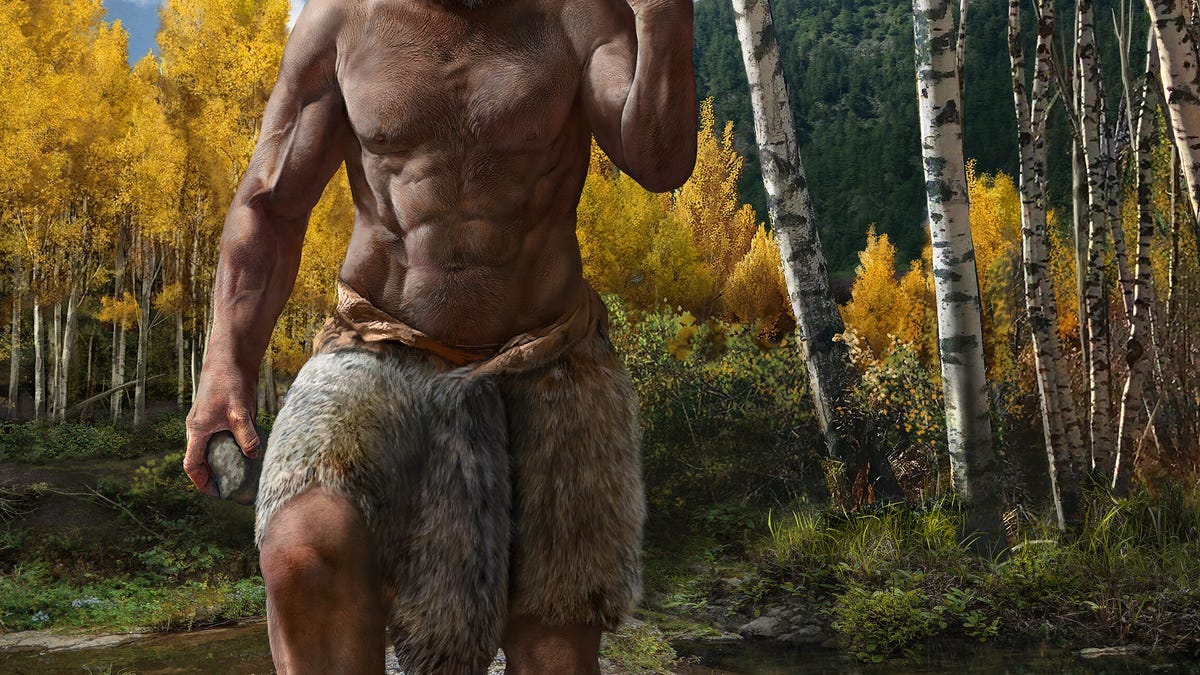Dragon Man Skull Dumbfounds, Digs Up Doubts About Human Evolution
The story of our species may run through a wartime construction project back to the wild and woolly steppes of Asia where Dragon people once roamed.

An illustration of Dragon Man at home.
One of the key pieces to the puzzle of our long narrative arc as a human species may have been hiding at the bottom of a well in China for almost a century. But now the nearly intact, ancient skull of what could be our closest extinct relative -- nicknamed Dragon Man -- is very much in the public eye as an object of intense scientific fascination and debate.
The story goes that a worker at a bridge construction site in the Chinese city of Harbin dug up the skull in 1933, but hid it in a well to keep it from falling into the hands of the occupying Japanese army. Its existence was only revealed by the worker's family in recent years and donated to the Hebei Geo University for study.
It turns out the worker's intuition that the skull could be significant was correct.
"The Harbin fossil is one of the most complete human cranial fossils in the world," says Qiang Ji, a professor of paleontology of Hebei Geo University and author of a study on the skull, in a statement. "This fossil preserved many ... details that are critical for understanding the evolution of the Homo genus and the origin of Homo sapiens."
The Harbin cranium is the true big box of skulls for the Homo genus. It's a massive dome with room for a modern human brain but with bigger and somewhat squared-off eye sockets, imposing brows, wide mouth and plus-sized teeth.
Scientists including Ji believe the skull, thought to have come from a male who lived to be about 50 years old, is a specimen of a previously unrecognized human species dubbed Homo longi or "Dragon Man." A trio of papers from the researchers was published Friday in a journal called The Innovation and make the provocative suggestion that we are closely related to Dragons, or at least to Dragon Man and Dragon Woman.
"Like Homo sapiens, they hunted mammals and birds, and gathered fruits and vegetables, and perhaps even caught fish," remarks co-author Xijun Ni, a professor of paleoanthropology at the Chinese Academy of Sciences and Hebei Geo University.
A virtual reconstruction of the Dragon Man skull.
Geochemical dating places the skull at 146,000 years or older, an era when human species were on the move along with woolly mammoths, woolly rhinoceros and perhaps giant beavers. It's also possible that Dragon Man and his clan would have come across early Homo sapiens.
"Altogether, the Harbin cranium provides more evidence for us to understand Homo diversity and evolutionary relationships," Ni says. "We found our long-lost sister lineage."
However, not all scientists -- not even all those on the research team -- agree about just how new of a species it might actually be.
"Harbin is better understood as a Denisovan," paleoanthropologist Karen Baab, who was not involved with the research, told The New York Times.
The Denisovans were an archaic human species that's thought to have roamed roughly the same area during the same period. But scientists base their knowledge of these extinct people on some DNA and very few remains, certainly nothing as substantial as the Dragon Man skull.
Skull comparisons among Peking Man, Maba, Jinniushan, Dali and Harbin specimens (from left to right).
So it might be, as Baab and others think, that the skull of Dragon Man is really the first glimpse we're getting of a Denisovan profile.
Chris Stringer from the National History Museum in London, who was a part of the research team, says he agrees that Dragon Man deserves a distinct species name, but thinks the skull might also be linked to the famous Dali Man skull, also found in China.
"I would prefer to place the Harbin and Dali fossils together as (Homo) daliensis," Stringer writes. "I also consider Harbin as a possible Denisovan, although much more work is needed there."
While few seem unanimous about the specific interpretation of what Dragon Man's debut means, Stringer speaks for numerous other scientists who agree it's a big deal.
"These differences of opinion," Stringer says, "should not deflect from a remarkable new piece in the jigsaw of human evolution, a fossil that will continue to add important information for many years to come."

